N. N. Jibiri, M. O. Olaluwoye, B. O. Ayinmode
Department of Physics, Faculty of Science, University of Ibadan, Ibadan, Nigeria
Correspondence to: B. O. Ayinmode, Department of Physics, Faculty of Science, University of Ibadan, Ibadan, Nigeria.
| Email: |  |
Copyright © 2015 Scientific & Academic Publishing. All Rights Reserved.
Abstract
This study was conducted to assess the level of Whole Body Vibration (WBV), Hand-Arm Vibration (HAV) and noise of generators used within some selected commercial areas in the city of Ibadan, Oyo State, Nigeria. A calibrated vibration meter and a sound level meter were employed in this study. Also, a semi-structured interviewer administered questionnaire was used to elicit information on users’ perception of vibration, auditory and non-auditory health effects associated with exposure to vibration and noise, which was subjected to Chi-square test at 5% level of significance. The results of this study indicated that the maximum value of the vibration weighted root mean square (WRMS) is 6.131m/s2, while the minimum is 2.158 m/s2. The maximum value of HAV is 282.77 m/s2 while the minimum is 280.368 m/s2. Also, the maximum value of noise is 103.46 dBA, while the minimum is 89.45dBA. The obtained maximum value of WBV, HAV and noise level are higher than the recommended value. There was an association between the users’ responses and some health effects at a p-value below 0.05. Therefore, there is an indication that the use of generators in these areas exposes users to health risk.
Keywords:
Generator, Health risk, Vibration, Whole Body Vibration, Hand-Arm Vibration, Noise
Cite this paper: N. N. Jibiri, M. O. Olaluwoye, B. O. Ayinmode, Assessment of Health Effects of Noise and Vibration Levels at Major Business Complexes and Markets in Ibadan Metropolis, Nigeria, Journal of Health Science, Vol. 5 No. 4, 2015, pp. 69-75. doi: 10.5923/j.health.20150504.02.
1. Introduction
Over the years, rapid technological development has resulted into the invention of so many equipments and machines such as power generating sets, vehicles and trucks, grinding machines, among others. Every day, human beings make use of these inventions and most times use them in ways that are detrimental to their human health, thereby resulting in injury like blanching, muscle weakness, fatigue, discomfort, hearing impairment etc. Electric power generators are made to serve as standby power source during a power failure. However, due to the irregular power supply in Nigeria, generators have been the primary source of power in homes and commercial areas [1] [2].Generators produce vibration and noise that can be detrimental to human if the body is being exposed over a long period on a regular basis. To deal with the complexity of these effects on the human body, it is customary to consider human vibration as either a Whole Body Vibration (WBV) problem and/or Hand-Arm Vibration (HAV) problem. WBV refers to the situation where the whole body is exposed to vibration through contact by the buttocks or feet, e.g. low back pain and discomfort; whereas HAV refers to where the hand/arm is exposed to vibration through contact, e.g. muscle aches and pains. These two classifications of vibration have different sources, affect different areas of the body and produce different symptoms ranging from barely perceivable levels, through uncomfortable, and up to hazardous levels as in some off-road vehicles [3] [4] [5]. It is generally believed that noise (defined loosely as “unwanted sound”) can reduce productivity, interfere with communication and concentration and in high exposures can cause permanent hearing loss [6] [7]. Thus, vibrations are perceived as a complement to loud noise in most community surveys of noise and are found to be an important factor in determining annoyance. Symptoms reported among industrial workers regularly exposed include nausea, headaches, anxiety and changes in mood [8] [9]. Ibadan, being a metropolitan city, encourages small and large-scale businesses, thus, the use of generators is common at homes, offices, markets and business centres. As a result, users may experience high levels of vibration and noise. The aim of this research is to determine the human health effects of vibration and noise of generators in some selected business areas of Ibadan.
2. Materials and Methods
2.1. Research Design
In this study, field data acquisition involves observing the type of generators being used at each measurement location, repeated field measurements of vibration magnitudes and noise levels from generators at specific identified shopping complexes. Also as a comparison between the level of exposure and the state of health of people in the study area, a standard questionnaire survey was designed to estimate the state of health of people (users) within the vicinity of some selected generators. Participants in these commercial locations were duly informed and were assured of confidentiality, privacy and anonymity of information provided. Only participants who provided informed consent were interviewed.
2.2. Research Area, Selection of Sites and Locations
This study was conducted in Agbowo, Iwo road, Pep, Pinnacle, Lord’s Favour, Foodco shopping complexes as well as Gbagi and Bodija markets, which are all located in Ibadan, the capital of Oyo State in Nigeria. These places are all high commercial activity areas encouraging small scale businesses, and use generators to enhance productivity of their daily tasks. Ibadan is also one of the largest metropolitan cities in West Africa and is primarily an indigenous city with millions of inhabitants, most of which are Yorubas; other ethnic groups constitute smaller proportions of the population [2].
2.3. Measurement Procedure
Whole Body Vibration, Hand-Arm Vibration and Noise measurements were done according to the measuring procedures outlined in International Standardization of Organization, ISO 2361-1; ISO 5349-1 and Health Safety Executive, HSE respectively. The generator vibration magnitudes were measured using a factory calibrated VM-6360 Model Vibration Meter, while the sound levels were measured using a factory calibrated AZ Digital Sound Level Meter (SLM), Model 8928. The vibration magnitudes and sound level of generators were obtained during the day (working hours). The distance between the generators and the operators were obtained using a measuring meter rule. Acceleration levels were measured on the floor which serves as a vibrating platform between the generator and the operator (as in the case of WBV). This was done due to the fact that users are not sitting directly or in direct contact with the generators while in operation, as it is the case in a moving vehicle or truck. This required the use of an accelerometer connected to the vibration meter VM-6360 which did the digital data recording and finally to a personal HP Laptop computer to amplify and store vibration data.The time required for fitting and removal of the transducer and the data acquisition system was about 10 minutes in order to minimize disruption of the commercial operations for which the machines are used (most especially in Gbagi and Bodija markets). The noise level meter was set at the slow response mode with A-weighting (A-weighted decibels or dBA).
2.4. Questionnaires Survey
During data collection, questionnaires were distributed randomly to generator users including people working around these generators. There were 400 participants in all (50 respondents in each of the commercial areas). The semi-structured questionnaire elicited information on demographic characteristics, vibration, auditory and non-auditory health problems experienced by users as well as other information.
2.5. Method of Analysis
The equivalent vibration acceleration-time histories in m/s2 obtained from the vibration meter was downloaded and entered into Microsoft Excel to obtain the weighted root mean square in m/s2 and then analyzed using ISO 2631-1 and ISO 5349-1 standards. Also, the time to reach EAV and ELV were obtained by a Vibration Exposure Software using (1). | (1) |
Where aw(t) is the weighted acceleration time history and T is the duration of the measurement.The Crest Factor (CF) is the ratio of the maximum (peak) weighted acceleration value to the weighted RMS. It is given as: | (2) |
Noise levels were also recorded and entered into Microsoft Excel and analyzed using HSE standard (85dBA tolerance level for human). Survey Data were managed and analyzed by Statistical Package for Social Sciences (SPSS) version 21 using descriptive statistics and Chi-square Test at 5% level of statistical significance.
3. Results
3.1. Generator Characteristics
During data collection, it was observed that Tiger and Elepaq generators are the most commonly used generators in Agbowo, Alakia and Iwo road shopping complexes; followed by Sumec, Thermocool and Yamaha Generators all with power ratings ranging from 0.5kVA – 5.0kVA. While Mikano generators with power rating between 60 – 150kVA were used to power Pep, Foodco and Pinnacle shopping plazas. All the generators used in Agbowo, Alakia, Iwo Road, Gbagi and Bodija are petrol engine generators, while that of Pep, Pinnacle and Foodco are diesel engine generators. During field measurements, it was observed that majority of the generators in Agbowo, Alakia and Iwo road were kept outdoors at relatively short distance away from users (Agbowo, 1.5 ± 0.3m, Iwo road; 1.7 ± 0.4m, Alakia 1.3 ± 0.8m) while that of Gbagi and Bodija markets were closely packed together. On the other hand, Pep, Pinnacle and Foodco properly confined their generators in a housed environment at about 5 – 10 metres away from the mall. Most of the respondents in Agbowo, Iwo road, Alakia, Gbagi and Bodija had spent more than 2 years in their present occupation as compared to few respondents in Pep, Pinnacle and Foodco who had spent less than a year in their present occupation. Also, a larger percentage (40%; 44%) of respondents at Gbagi and Bodija are uneducated while others have primary education; 36%, 40%; 34% of respondents in Agbowo, Iwo road and Alakia have secondary education respectively as others have primary education. 34%, 22%, 28% of respondents in Pep, Pinnacle and Foodco have tertiary education respectively and other percentages have secondary education.
3.2. Result of Exposure Measurement
Tables 1a to 1c, 2a to 2b and 3a to 3c present the field measurement results of WBV, HAV and Noise measurements respectively. Also, questionnaire results are presented in Tables 4 to 9, based on the demographic characteristics, vibration, auditory and non-auditory health problems experienced by users.Table 1a. Whole Body Vibration Exposure at 1m in the measurement Locations
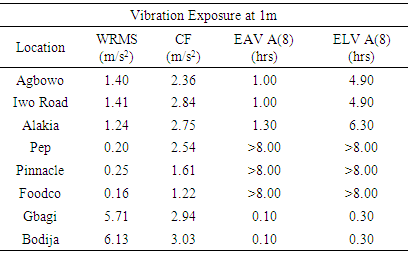 |
| |
|
Table 1b. Whole Body Vibration Exposure at 2m in the measurement Locations
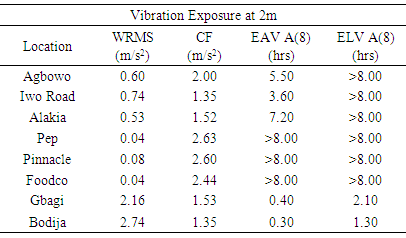 |
| |
|
Table 1c. Whole Body Vibration Exposure at 3m in the measurement Locations
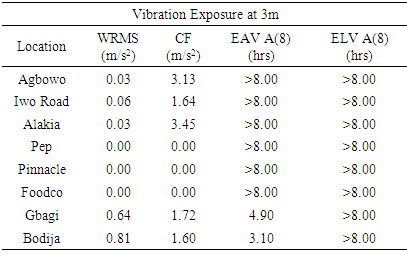 |
| |
|
Table 2a. Hand-arm Vibration (HAV) Exposure at Gbagi Markets
 |
| |
|
Table 2b. Hand-arm Vibration (HAV) Exposure at Bodija Markets
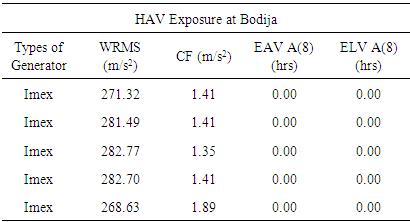 |
| |
|
Table 3a. Noise Exposure at 1m in the Measurement Locations
 |
| |
|
Table 3b. Noise Exposure at 3m in the Measurement Locations
 |
| |
|
Table 3c. Noise Exposure at 5m in the Measurement Locations
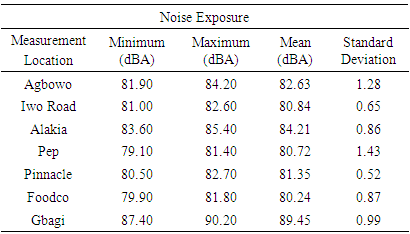 |
| |
|
Table 4. Socio-demographic Characteristics of 50 respondents in each commercial area
 |
| |
|
Table 5. Users’ perception of vibration effects (N = 50)
 |
| |
|
Table 6. User’s perception of noise effects (N = 50)
 |
| |
|
Table 7. Whole Body Vibration Effects experienced by Generator users (N = 50)
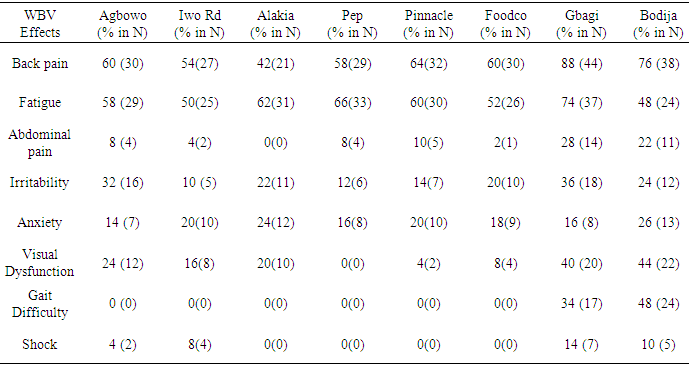 |
| |
|
Table 8. Hand-Arm Vibration Effects experienced by Generator users (N = 50)
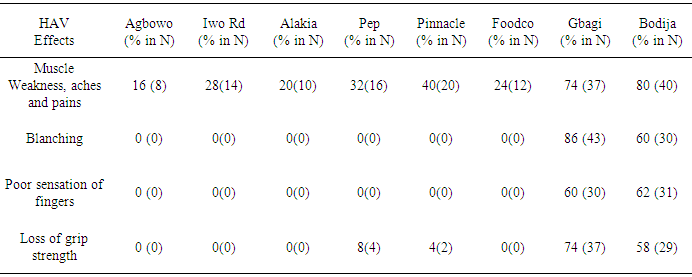 |
| |
|
Table 9. Noise Health Effects Experienced by Generator Users (N=50)
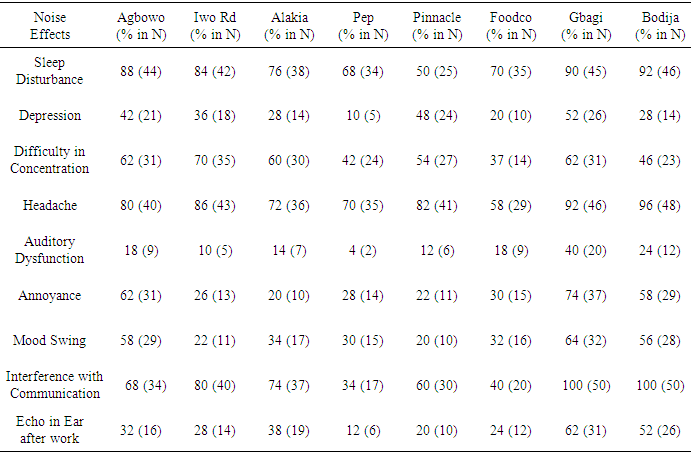 |
| |
|
3.3. User’s Knowledge and Perception of Health Hazards Associated with Generator Use
Users’ responses from Table 5 indicates that majority of the respondents are not aware that the vibration of generators while in operation can be detrimental to their health (p-value < 0.05). In a 2006 survey of U.S. safety and health professionals conducted to determine knowledge and awareness of WBV, the analysis of the data revealed a relatively low knowledge of the topic; 69.5% of the respondents reported having less than a basic understanding of WBV.However, users’ responses in Table 6 indicates majority of respondents in Agbowo (84%), Iwo Road (64%), Alakia (70%), Pep (62%), Foodco (56%), Gbagi (86%), Bodija (68%) and slightly less than half in proportion of respondents in Pinnacle (40%) are well aware of the adverse effect of noise exposure from their generators (p < 0.05).
4. Discussion
The findings from this study in Table 1a shows that generator users in Agbowo, Iwo road, Alakia, Gbagi and Bodija are exposed to WBV as the WRMS acceleration at 1m away from the generator is above the recommended daily exposure limit value of 1.15m/s2, while WRMS is below recommended exposure action value of 0.5m/s2 in Pep, Pinnacle and Foodco. As a result of the user’s short distance to generators, majority of respondents in Agbowo, Iwo road, Alakia indicated they experienced WBV effects; especially back pain, fatigue, irritability and visual dysfunction (Table 7). Same can be said in the case of users at Gbagi and Bodija markets, where the traders stand almost all day on the vibrating floor. However, the effects of vibration on generator users depend upon so many physical, biodynamic and individual factors. A similar study [10] showed that magnitude of the effect of vibration depends on the severity and length of exposures.At 2m away from the generator (Table 1b), the observed WRMS values of WBV at Gbagi and Bodija is well above the risk level of 1.15m/s2 which can lead to adverse health effects. WRMS acceleration in Agbowo, Iwo road and Alakia is slightly above the recommended EAV value, which may lead to likely health risks (as stated above) if the exposure is up to 4 hours at Agbowo, Iwo road and 8 hours in Alakia and caution is not taken. At Pep, Pinnacle and Foodco no clear effects is experienced as the observed WRMS is below the recommended EAV of 0.5m/s2. Based on the results, users at Pep, Pinnacle and Foodco will experience no health effects of WBV due to their far distance to the generator.At 3m (Table 1c), WRMS value in Gbagi and Bodija is above the recommended EAV of 0.5m/s2, there is a tendency of experiencing WBV effects in 4 hours; in the case of Agbowo, Iwo road, Alakia, Pep, Pinnacle and Foodco, the observed WRMS value shows there is no possible effects. This indicates that the likely health effects of WBV experienced by users tend to reduce with distance. It was also observed during measurements that the vibration of each generator in the complex have been minimized by mounting the generator on an isolated platform (to attenuate vibration). As a result vibration could not travel much through the floor, thus the accelerometer could not sense much vibration on the floor. A highly rigid support structure can tolerate a greater amount of ambient vibration [11]. Hence, majority of respondents (Table 7) could not experience WBV effects. The few who experienced back pain, fatigue and other effects may be as a result of the nature of their work which requires moving of goods from one place to another.In the experiments conducted on different grinding machines powered by generators at Gbagi and Bodija (as seen in Table 2a – 2b), it was observed that the WRMS values of HAV acceleration is extremely above health risk level of 5.0m/s2 considering 8 hours exposure duration. These high magnitudes are dangerous even considering short duration of exposure. Thus, users are exposed to chronic hand-arm vibration effect such as blanching, muscle weakness, aches and pains, poor sensation of the fingers as a result of how tightly they hold the grinding machines. Shivakumara & Sridhar (2010) [12] in their study concluded that the vibration with acceleration more than 2.5m/s2 is found to be extremely uncomfortable and is a better indicator of the effects on the health of user. The respondents experience in Table 8 shows majority of respondents in Gbagi and Bodija experienced HAVS – poor sensation of fingers, blanching, loss of grip strength as well as muscle weakness, aches and pains. From experimental results, both HAV and WBV act together while using grinding machines powered by generators. This indicates that generator users at Gbagi and Bodija experience chronic WBV and HAV effects at the same time. A similar study proved that HAV exposures occur with higher vibration energy applied to the fingers and hands using powered hand tools/machines, resulting in known adverse health effects such as “white finger” [13].The mean noise levels emitted from generators at 1m in Agbowo, Iwo road, Alakia, Pep, Pinnacle, Foodco, Gbagi and Bodija were 95.32 ± 0.71, 92.11 ± 0.42, 91.15 ± 1.46, 87.76 ± 0.54, 88.73 ± 0.73, 87.63 ± 0.48, 101.80 ± 1.42 and 103.46 ± 2.10 respectively (Table 3a). In comparison with HSE 2005 regulations of human tolerance to noise level (85dBA), these results have serious public health implications and could result in deleterious auditory conditions such as hearing impairment. Non auditory conditions such as annoyance may also occur. A recent study [14] revealed highest noise level of 99 dBA from generator houses in quarries and neighbouring communities. They further reported over 80% of respondents experienced frequent annoyance episodes. Due to the relatively short distance of respondents to the generator, majority of respondents in Agbowo, Iwo road, Alakia, Gbagi and Bodija experience sleep disturbance as well as headache (Table 9). Similar studies revealed that high noise levels can cause insufficient sleep and rest which can also lead to mood shifts, irritability, headache and tertiary annoyance on members of the community [15] [16]. This may be responsible for the sleep disturbance and headache responses observed among respondents in this study.At 3m away from generators, it was observed that the mean noise levels in Agbowo, Iwo road, Alakia, Pep, Pinnacle, Foodco, Gbagi and Bodija were 91.67 ± 1.43, 86.82 ± 1.42, 86.78 ± 1.49, 85.33 ± 1.47, 86.42 ± 1.36, 85.41 ± 1.56, 95.15 ± 1.57 and 98.68 ± 1.64 respectively (Table 3b). Although there was decrease in the mean noise levels in Iwo road, Alakia, Pep, Pinnacle and Foodco which makes it a bit safe for users just for a period of 6 – 8 hours; the mean noise levels at Agbowo, Gbagi and Bodija could still result in serious auditory impairment within 15 minutes to 1 hour as the case may be. The mean noise levels at 5m away from generators in Agbowo, Iwo road, Alakia, Pep, Pinnacle, Foodco, Gbagi and Bodija were 82.63 ± 1.28, 80.84 ± 0.65, 84.21 ± 0.86, 80.72 ± 1.43, 81.35 ± 0.52, 80.24 ± 0.87, 89.45 ± 0.99 and 90.03 ± 1.04 respectively as shown in Table 3c. These results indicate with distances away from generators, noise levels tend to reduce considerably. However, the mean noise levels at Gbagi and Bodija still pose health risks, which is the result of the environment being a market area.From the chi-square analysis of the questionnaire in Tables 7 – 9, calculated values of Chi-Square (χ2) [WBV = 106.053; HAV = 667.7741 and Noise = 240.1598] at 0.05 alpha level of significance with 7 degrees of freedom is greater than critical value (14.067) of Chi-Square (χ2) which means that the p-value is below 0.05 (p-value < 0.05). This implies that operating generator sets affect the human body significantly in terms of WBV, HAV and Noise.Majority of the respondents think they are prone to hazards from generator use in terms of noise, and surprisingly few proportion of respondents felt vibration from generators have no significant effect on their health. Hence, this study has found that despite high level of awareness of hazard of noise induced hearing loss due to use of generators, majority of the respondents did nothing to protect themselves from the hazard because of ignorance on the measures that need to be taken.Table 10. Recommended Exposure Action & Limit Values for WBV, HAV and Noise
 |
| |
|
5. Conclusions
Vibration and noise are physical disturbances that occur generally in machines (generators inclusive). This study has shown that there is a high prevalence of the use of generators among generator users in the study area, thus, exposing them to both vibration and noise induced health effects. However, exposure damage to human body reduces with distance from generators as a result of damping effect. Also, this study confirmed that users of generators are unaware of the vibration effects of generators on their health while a considerable number of the users are aware that high noise level has negative effects on their health. Therefore, generator users should take precautionary measures such as wearing proper hearing protection devices (such as ear muffs, formable ear plugs) to protect their ears, use of rubber mats and shoes with thick rubber sole as well as recommended anti-vibration hand-gloves. Occupational health and safety management should be carried out to prevent adverse health effects in generator users; in addition, health education on the hazards of generator use (risk of noise to the ears; WBV and HAV health risks) should be promoted in our society to improve user’s awareness.
References
| [1] | Ibitoye, F. I. and Adenikinju, A, 2007, Future demand for electricity supply in Nigeria. Applied Energy. 84(5), 492- 504. |
| [2] | Yesufu L.A., Ana G.R.E.E., Umar O.K., 2013, Knowledge and Perception of Noise Induced Health Hazards Associated with Generator use in Selected Commercial Areas in Ibadan, Nigeria. International Journal of Collaboration Research on Internal Medicine and Public Health Hazards, 5(9), 581 – 595. |
| [3] | Griffin, M. J., 2003, Handbook of Human Vibration, Second printing ed., Academic Press, London. |
| [4] | Mansfield, N. J., 2005, Human response to vibration, CRC Press, Boca Raton. |
| [5] | Marjanen, Y., 2005, Using ISO 2631-5 as an additional whole body vibration evaluation method with ISO 2631-1 to include also transient shocks to the analysis, Paper presented at the 12th International Congress on Sound and Vibration, Lisbon, Portugal. |
| [6] | Stephen A.S. and Mark P.M., 2003, Noise Pollution: Non-Auditory Effects on Health, Oxford Journals of Medicine and Health British Medical Bulletin, 68(1), 243 – 257. |
| [7] | Michael R. and Mark A.W.A., 2009, How does Background Noise affect our Concentration? Seton Hill University, Greensburg. |
| [8] | Yesufu A. L and Ana G. R. E. E., 2012, Electric Generator Characteristics, Pattern of Use and Non Auditory Health Effects Experienced by Commercial Workers in Agbowo and Ajibode Areas of Ibadan, Nigeria, Review of Global Medicine and Healthcare Research, 3(2). 159-171. |
| [9] | Barbara M., Gary F. and Airdrie L., 2009, Bad Vibration: A Handbook on Whole Body Vibration Exposure in Mining, Joint Coal Board Health and Safety Trust, Sidney, Australia. |
| [10] | Segerink F.B., Korterik J.P., Offerhaus H.L., 2011, Vibration Transfers to Measure the Performance of Vibration Isolated Platforms on Site Using Background Noise Excitation, Review of Scientific Instruments, 82,[doi:10.1063/1.3602331]. |
| [11] | Shivakumara B.S. and Sridhar V, 2010, Study of vibration and its effect on health of the motorcycle rider. Online J Health Allied Scs., 9(2), 1-4. |
| [12] | Janicak, C.A., 2004, Preventing HAVS in the workplace. Professional Safety, 49(1), 35-40. |
| [13] | Onuu, M. U. and Tawo, A. N., 2006, Industrial noise studies in quarries and neighbouring communities, International Journal of Natural and Applied Sciences, 1(1). 94 –100. |
| [14] | Singh, N. and Davar, S.C., 2004, Noise Pollution-Sources, Effects and Control, J. Hum. Ecol., 16(3). 181-187. |
| [15] | Essandoh, P. K. and Arma, F. A., 2011, Determination of Ambient Noise Levels in the Main Commercial Area of Cape Coast, Ghana, Research Journal of Environmental and Earth Sciences, 3(6). 637-644. |



 Abstract
Abstract Reference
Reference Full-Text PDF
Full-Text PDF Full-text HTML
Full-text HTML













